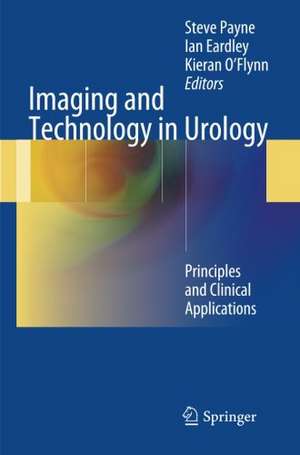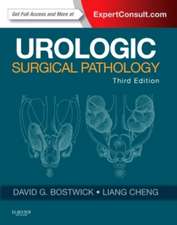Imaging and Technology in Urology: Principles and Clinical Applications
Editat de Steve Payne, Ian Eardley, Kieran O'Flynnen Limba Engleză Paperback – 9 mai 2014
| Toate formatele și edițiile | Preț | Express |
|---|---|---|
| Paperback (1) | 910.82 lei 6-8 săpt. | |
| SPRINGER LONDON – 9 mai 2014 | 910.82 lei 6-8 săpt. | |
| Hardback (1) | 1295.04 lei 6-8 săpt. | |
| SPRINGER LONDON – 13 apr 2012 | 1295.04 lei 6-8 săpt. |
Preț: 910.82 lei
Preț vechi: 958.76 lei
-5% Nou
Puncte Express: 1366
Preț estimativ în valută:
174.29€ • 186.37$ • 145.32£
174.29€ • 186.37$ • 145.32£
Carte tipărită la comandă
Livrare economică 17 aprilie-01 mai
Preluare comenzi: 021 569.72.76
Specificații
ISBN-13: 9781447160120
ISBN-10: 1447160126
Pagini: 404
Ilustrații: XVI, 388 p.
Dimensiuni: 155 x 235 x 21 mm
Greutate: 0.56 kg
Ediția:2012
Editura: SPRINGER LONDON
Colecția Springer
Locul publicării:London, United Kingdom
ISBN-10: 1447160126
Pagini: 404
Ilustrații: XVI, 388 p.
Dimensiuni: 155 x 235 x 21 mm
Greutate: 0.56 kg
Ediția:2012
Editura: SPRINGER LONDON
Colecția Springer
Locul publicării:London, United Kingdom
Public țintă
Professional/practitionerCuprins
Part 1 – Imaging: Radiology.- Principles of X-ray Production and Radiation Protection.- How to Perform a Clinical Radiograph and Use a C-arm.- Contrast agents.- How to do an IVU.- Dual Energy X-Ray Absorptiometry (DXA).- The physics of ultrasound.- How to Ultrasound a Suspected Renal Mass.- How to Ultrasound a Painful Testis and a Testicular Mass.- How to Perform a Trans-Rectal Ultrasound Scan and Prostate Biopsy.- How to Manage a Hydronephrotic Kidney.- Principles of Computed Tomography (CT).- How to do a CT Urogram (CTU).- How to do a CT in a Patient with Presumed Upper Tract Trauma.- Principles of Magnetic Resonance Imaging (MRI).- How to do an MRI of the Pelvis.- Magnetic Resonance Angiography (MRA).- Vascular Embolization Techniques in Urology.- Part 2 – Imaging: Nuclear Medicine.- Radionuclides and their Uses in Urology.- Counting and Imaging in Nuclear Medicine.- Principles of Positron Emission Tomography (PET) Scanning.- How to do a Renogram.- How to do a Diuresis Renogram.-How to do a DMSA Scan.- How to do a Radioisotope Glomerular Filtration Rate Study.- How to do a Bone Scan.- How to do a Transplant Renogram.- Dynamic Sentinel Lymph Node Biopsy in Penile Cancer.- Part 3 – Technology: Diagnostic.- Urinalysis.- Principles of Urine Microscopy and Microbiological Culture.- Measurement of Glomerular Filtration Rate (GFR).- Metabolic Assessment of Urinary Tract Stones.- Principles of Pressure Measurement.- Principles of Measurement of Urinary Flow.- How to Carry Out a Videocystometrogram (VCMG).- The Whitaker test.- Sphincter electromyography (EMG).- Tumour Markers.- Urine Cytology.- Histopathological Processing, Staining and Immunohistochemistry.- Part 4 – Technology: Operative.- Principles of Urological Endoscopes.- Rigid Endoscope Design.- Light Sources, Light Leads and Camera Systems.- Peripherals for Endoscopic Use.- Peripherals for laparoscopic use.- Peripherals for mechanical stone manipulation.- Contact lithotripters.- Endoscopic use of Laser Energy.- Double J Stents and Nephrostomy.- Urinary Catheters, Design and Usage.- Prostatic and Urethral Stents.- Urological Prosthetics.- Meshes in Stress Urinary Incontinence and Pelvic Organ Prolapse.- Biological meshes.- Principles of Tissue Transfer in Urology.- Theatre Design and Patient Safety.- Deep Venous Thrombosis (DVT) Prevention.- Principles of Decontamination.- Operative Tissue Destruction.- Sutures and Clips.- Monopolar Diathermy.- Bipolar Diathermy.- Alternatives to Electro-Surgery.- Haemostatic Agents, Sealants and Adhesives.- Irrigation Fluids and their Hazards.- Insufflants and their Hazards.- Laparoscopic Ports.- Setting up a Robot.- Part 5 – Technology: Interventional.- Neuromodulation by sacral nerve stimulation.- Principles of Extracorporeal Shockwave Lithotripsy (ESWL).- How to carry out Shockwave Lithotripsy.- Prostatic Hyperthermia.- Ablative Therapies: High Intensity Focused Ultrasound (HIFU), Cryotherapy and Radio-Frequency Ablation (RFA).- Principles of Radiotherapy.- Electro-Motive Drug Administration (EMDA).- Part 6 - Technology of Renal Failure.- Principals of Renal Replacement Therapy (RRT).- Principals of Peritoneal Dialysis.- Haemodialysis.- Principles of Renal Transplantation.- Part 7 - Assessment of Technology.- Randomised Controlled Trials (RCTs).- Health Technology Assessment.
Recenzii
From the reviews:
“Chapters in this book is a focused snapshot of the technologies and techniques that are commonly used in urologic practice. … Although it is intended as a quick reference for practicing urologists and a study guide for training physicians … the book could serve equally well as a valuable reference for urology trainees in other countries. Its compact, easy-to-read chapters would be helpful for … healthcare specialists seeking to quickly reinforce their knowledge of the facts behind the technologies used in everyday urology.” (Costas E. Lallas, Doody’s Review Service, July, 2012)
“Chapters in this book is a focused snapshot of the technologies and techniques that are commonly used in urologic practice. … Although it is intended as a quick reference for practicing urologists and a study guide for training physicians … the book could serve equally well as a valuable reference for urology trainees in other countries. Its compact, easy-to-read chapters would be helpful for … healthcare specialists seeking to quickly reinforce their knowledge of the facts behind the technologies used in everyday urology.” (Costas E. Lallas, Doody’s Review Service, July, 2012)
Textul de pe ultima copertă
Imaging and Technology in Urology: Principles and Clinical Applications is a practical and user-friendly consolidated source book for urologists, and urologists in training, regarding the basic science of imaging modalities used on a day-to-day basis in urological practice. Similarly, the intention is to provide an introduction to the technology that is used in the practice of urological surgery and the management of urological patients in the clinical setting. This knowledge is one of the eight separate disciplines examined in the oral component of the knowledge examination for independent, consultant, practice in urology in the UK. The book is also valuable to urologists and urological trainees outside of the UK and in other surgical specialities.
Caracteristici
Being a consolidated source book, this book provides a wealth of information in a clinical situation and is sufficient to fulfil requirement for post-graduate exams The books small chapters and facing page construction allows for accessible information at a glance, meaning its simple layout is useful as a revision guide for urologists in training, as well as a point of reference in other areas of urology The illustrations consist simply of line diagrams and clinical radiographs, with a maximum of 4 per section, presenting an easy understanding of applied physics, as will be encountered in clinical scenario testing in post-graduate exams
Descriere
Descriere de la o altă ediție sau format:
Imaging and Technology: Principles and Clinical Applications is a practical and user-friendly consolidated source book for urologists, and urologists in training, regarding the basic science of imaging modalities used on a day-to-day basis in urological practice. Similarly, the intention is to provide an introduction to the technology that is used in the practice of urological surgery and the management of urological patients in the clinical setting. This knowledge level is appropriate for certification for independent consultant practice in urology in the UK. The book is also valuable to urologists and urological trainees outside of the UK and in other surgical specialities.
Imaging and Technology: Principles and Clinical Applications is a practical and user-friendly consolidated source book for urologists, and urologists in training, regarding the basic science of imaging modalities used on a day-to-day basis in urological practice. Similarly, the intention is to provide an introduction to the technology that is used in the practice of urological surgery and the management of urological patients in the clinical setting. This knowledge level is appropriate for certification for independent consultant practice in urology in the UK. The book is also valuable to urologists and urological trainees outside of the UK and in other surgical specialities.















